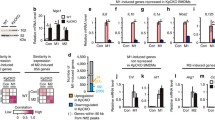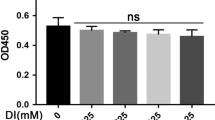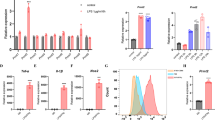Abstract
Reactive oxygen species (ROS) play an essential role in macrophage polarization. However, the adverse effects of ROS reduction by influencing epigenetics are often ignored. In this study, lipopolysaccharide (LPS) was used to stimulate macrophages to increase the ROS in cells, and N-acetylcysteine (NAC) was used to reduce ROS. Inflammatory factors such as interleukin 1β (IL-1β), interleukin 6 (IL-6), and tumor necrosis factor α (TNF-α) were used to evaluate the M1 polarization level of macrophages. Chip was used to detect the tri-methylation at lysine 27 of histone H3 (H3K27me3) level at the promoter site. It was found that the decrease of ROS in macrophages would also cause the increase of the H3K27me3 demethylase KDM6A and lead to the reduction of H3K27me3 in the NOX2 promoter, which would increase the transcription level of NOX2 and the production of ROS and ultimately promote the production of inflammatory factors. Knockout of KDM6A can reduce the transcription of NOX2 and the production of ROS of macrophages, thus preventing the M1 polarization of macrophages. The elimination of ROS in macrophages will affect macrophages by increasing KDM6A and making them produce more ROS, thus inducing oxidative stress. In comparison, direct inhibition of KDM6A can reduce ROS production and inhibit macrophage M1 polarization more effectively.





Similar content being viewed by others
References
Aruoma OI, Halliwell B, Hoey BM, Butler J (1989) The antioxidant action of N-acetylcysteine: its reaction with hydrogen peroxide, hydroxyl radical, superoxide, and hypochlorous acid. Free Radic Biol Med 6:593–597
Bavarsad Shahripour R, Harrigan MR, Alexandrov AV (2014) N-acetylcysteine (NAC) in neurological disorders: mechanisms of action and therapeutic opportunities. Brain Behav 4:108–122
Bosselut R (2016) Pleiotropic functions of H3K27Me3 demethylases in immune cell differentiation. Trends Immunol 37:102–113
Ferreira LF, Campbell KS, Reid MB (2011) N-acetylcysteine in handgrip exercise: plasma thiols and adverse reactions. Int J Sport Nutr Exerc Metab 21:146–154
Gluschko A, Herb M, Wiegmann K, Krut O, Neiss WF, Utermohlen O, Kronke M, Schramm M (2018) The beta(2) Integrin Mac-1 induces protective LC3-associated phagocytosis of listeria monocytogenes. Cell Host Microbe 23(324-337):e325
Guzik TJ, Sadowski J, Guzik B, Jopek A, Kapelak B, Przybylowski P, Wierzbicki K, Korbut R, Harrison DG, Channon KM (2006) Coronary artery superoxide production and nox isoform expression in human coronary artery disease. Arterioscler Thromb Vasc Biol 26:333–339
Hoen PA, Van der Lans CA, Van Eck M, Bijsterbosch MK, Van Berkel TJ, Twisk J (2003) Aorta of ApoE-deficient mice responds to atherogenic stimuli by a prelesional increase and subsequent decrease in the expression of antioxidant enzymes. Circ Res 93:262–269
Jarmuszkiewicz W, Dominiak K, Galganski L, Galganska H, Kicinska A, Majerczak J, Zoladz JA (2020) Lung mitochondria adaptation to endurance training in rats. Free Radic Biol Med 161:163–174
Jinnouchi H, Guo L, Sakamoto A, Torii S, Sato Y, Cornelissen A, Kuntz S, Paek KH, Fernandez R, Fuller D et al (2020) Diversity of macrophage phenotypes and responses in atherosclerosis. Cell Mol Life Sci 77:1919–1932
Judkins CP, Diep H, Broughton BR, Mast AE, Hooker EU, Miller AA, Selemidis S, Dusting GJ, Sobey CG, Drummond GR (2010) Direct evidence of a role for Nox2 in superoxide production, reduced nitric oxide bioavailability, and early atherosclerotic plaque formation in ApoE-/- mice. Am J Physiol Heart Circ Physiol 298:H24–H32
Kang Q, Yang C (2020) Oxidative stress and diabetic retinopathy: molecular mechanisms, pathogenetic role and therapeutic implications. Redox Biol 37:101799
Kittan NA, Allen RM, Dhaliwal A, Cavassani KA, Schaller M, Gallagher KA, Carson WF IV, Mukherjee S, Grembecka J, Cierpicki T, Jarai G (2013) Cytokine induced phenotypic and epigenetic signatures are key to establishing specific macrophage phenotypes. PLoS One 8:e78045
Li Y, Quan X, Li X, Pan Y, Zhang T, Liang Z, Wang Y (2019) Kdm6A protects against hypoxia-induced cardiomyocyte apoptosis via H3K27me3 Demethylation of Ncx Gene. J Cardiovasc Transl Res 12:488–495
Liu H, Chen Z, Weng X, Chen H, Du Y, Diao C, Liu X, Wang L (2020) Enhancer of zeste homolog 2 modulates oxidative stress-mediated pyroptosis in vitro and in a mouse kidney ischemia-reperfusion injury model. FASEB J 34:835–852
Mantovani A, Sica A, Locati M (2005) Macrophage polarization comes of age. Immunity 23:344–346
Mikhed Y, Gorlach A, Knaus UG, Daiber A (2015) Redox regulation of genome stability by effects on gene expression, epigenetic pathways and DNA damage/repair. Redox Biol 5:275–289
Mlejnek P, Dolezel P, Kriegova E, Pastvova N (2021) N-acetylcysteine can induce massive oxidative stress, resulting in cell death with apoptotic features in human leukemia cells. Int J Mol Sci 22:12635
Niu Y, DesMarais TL, Tong Z, Yao Y, Costa M (2015) Oxidative stress alters global histone modification and DNA methylation. Free Radic Biol Med 82:22–28
Pedre B, Barayeu U, Ezerina D, Dick TP (2021) The mechanism of action of N-acetylcysteine (NAC): the emerging role of H(2)S and sulfane sulfur species. Pharmacol Ther 228:107916
Pollock JD, Williams DA, Gifford MA, Li LL, Du X, Fisherman J, Orkin SH, Doerschuk CM, Dinauer MC (1995) Mouse model of X-linked chronic granulomatous disease, an inherited defect in phagocyte superoxide production. Nat Genet 9:202–209
Raghu G, Berk M, Campochiaro PA, Jaeschke H, Marenzi G, Richeldi L, Wen FQ, Nicoletti F, Calverley PMA (2021) The multifaceted therapeutic role of N-Acetylcysteine (NAC) in disorders characterized by oxidative stress. Curr Neuropharmacol 19:1202–1224
Rushworth GF, Megson IL (2014) Existing and potential therapeutic uses for N-acetylcysteine: the need for conversion to intracellular glutathione for antioxidant benefits. Pharmacol Ther 141:150–159
Tabas I (2010) Macrophage death and defective inflammation resolution in atherosclerosis. Nat Rev Immunol 10:36–46
Talasaz AH, Khalili H, Fahimi F, Mojtaba S (2011) Potential role of N-acetylcysteine in cardiovascular disorders. Therapy 8:237–245
Thiele H, Hildebrand L, Schirdewahn C, Eitel I, Adams V, Fuernau G, Erbs S, Linke A, Diederich KW, Nowak M et al (2010) Impact of high-dose N-acetylcysteine versus placebo on contrast-induced nephropathy and myocardial reperfusion injury in unselected patients with ST-segment elevation myocardial infarction undergoing primary percutaneous coronary intervention. The LIPSIA-N-ACC (Prospective, Single-Blind, Placebo-Controlled, Randomized Leipzig Immediate PercutaneouS Coronary Intervention Acute Myocardial Infarction N-ACC) Trial. J Am Coll Cardiol 55:2201–2209
Tran N, Broun A, Ge K (2020) Lysine demethylase KDM6A in differentiation, development, and cancer. Mol Cell Biol 40:e00341–e00320
Van den Bossche J, Neele AE, Hoeksema MA, de Winther MP (2014) Macrophage polarization: the epigenetic point of view. Curr Opin Lipidol 25:367–373
Wierda RJ, Rietveld IM, van Eggermond MC, Belien JA, van Zwet EW, Lindeman JH, van den Elsen PJ (2015) Global histone H3 lysine 27 triple methylation levels are reduced in vessels with advanced atherosclerotic plaques. Life Sci 129:3–9
Wolfram T, Schwarz M, Reuss M, Lossow K, Ost M, Klaus S, Schwerdtle T, Kipp AP (2020) N-acetylcysteine as modulator of the essential trace elements copper and zinc. Antioxidants (Basel) 9:1117
Xu K, Liu X, Wen B, Liu Y, Zhang W, Hu X, Chen L, Hang W, Chen J (2022) GSK-J4, a Specific histone lysine demethylase 6A inhibitor, ameliorates lipotoxicity to cardiomyocytes via preserving H3K27 methylation and reducing ferroptosis. Front Cardiovasc Med 9:907747
Zhang Q, Ju Y, Ma Y, Wang T (2018) N-acetylcysteine improves oxidative stress and inflammatory response in patients with community acquired pneumonia: a randomized controlled trial. Medicine (Baltimore) 97:e13087
Zhang B, Yang Y, Yi J, Zhao Z, Ye R (2021) Hyperglycemia modulates M1/M2 macrophage polarization via reactive oxygen species overproduction in ligature-induced periodontitis. J Periodontal Res 56:991–1005
Zhou D, Yang K, Chen L, Zhang W, Xu Z, Zuo J, Jiang H, Luan J (2017) Promising landscape for regulating macrophage polarization: epigenetic viewpoint. Oncotarget 8:57693–57706
Zhou Y, Que KT, Zhang Z, Yi ZJ, Zhao PX, You Y, Gong JP, Liu ZJ (2018) Iron overloaded polarizes macrophage to proinflammation phenotype through ROS/acetyl-p53 pathway. Cancer Med 7:4012–4022
Zyoud SH, Awang R, Sulaiman SA, Al-Jabi SW (2011) N-acetylcysteine-induced headache in hospitalized patients with acute acetaminophen overdose. Fundam Clin Pharmacol 25:405–410
Funding
This work was supported by grants from the National Key Research and Development Program of China (No.2019YFA0210100)
Author information
Authors and Affiliations
Contributions
Wei Sun and Xiangqing Kong conceived the project and designed the experiments. Yunxi Zhao and Wei Sun wrote the manuscript. Yunxi Zhao, Luyang Wang, and Mingwei Liu performed most experiments. Ming Qiu, Anning Du, Huanyu Shu, and Lu Li assisted Yunxi Zhao with some experiments. All authors contributed to the article and approved the submitted version.
Corresponding author
Ethics declarations
Conflict of interest
The authors declare no competing interests.
Additional information
Publisher’s note
Springer Nature remains neutral with regard to jurisdictional claims in published maps and institutional affiliations.
Supplementary Information

Fig. 1
: NAC transiently inhibits LPS-induced increase of ROS level in RAW. (A-C) Typical and statistical diagrams of DCFH staining of RAWs treated with 1mg/ml LPS or 3mM NAC for 8h, and RAWs treated with 1mg/ml LPS and 3mM NAC for 8h or 16h, scale bar 100μm. (D) The mRNA levels of NOX2 was detected by qRT PCR after RAWs were treated with 1mg/ml LPS and 3mM NAC for 8h. The above data represent three independent repeated experiments, and the data are presented in the form of mean value ± standard deviation (S.D) *P<0.05, **<0.01, ***<0.001, ****<0.0001, ns, no significance. (PNG 127 kb)

Fig. 2
: NAC temporarily inhibits LPS induced M1 polarization of macrophages (A-E) The mRNA levels of IL1-β, IL-6, TNF-α, CD80, and CD86 were detected by RT qPCR after RAWs treated with 1mg/ml LPS or 3mM NAC for 8h, and RAWs treated with 1mg/ml LPS and 3mM NAC for 8h or 16h. The above data represent three independent repeated experiments, and the data are presented in the form of mean value ± standard deviation (S.D) *P<0.05, **<0.01, ***<0.001, ****<0.0001, ns, no significance. (PNG 81 kb)

Fig. 3
: NAC cannot reduce KDM6A transcription in RAW (A-B) The mRNA levels of KDM6A and KDM6B were detected by RT qPCR after RAWs were treated with 1mg/ml LPS and 3mM NAC for 8h (C)The mRNA levels of KDM6B were detected by RT qPCR after THP-1-derived macrophages treated with 1mg/ml LPS and 3mM NAC for 8h. The above data represent three independent repeated experiments, and the data are presented in the form of mean value ± standard deviation (S.D) *P<0.05, **<0.01, ***<0.001, ****<0.0001, ns, no significance. (PNG 1724 kb)

Fig. 4
: Macrophages with different H3K27 methylation levels exist in atherosclerotic plaque (A) Typical diagrams of CD68, H3K27me2, and H3K27me3 level of the aortas of Apoe-/- or C57BL/6 mice fed by western dite for 16 weeks detected by immunofluorescence staining, scale bar 50μm. (High H3K27me2 and high H3K27me3 marked by yellow arrows, low H3K27me2 and low H3K27me3 marked by white arrows.) (PNG 136 kb)
Table 1.
Supplementary Table 2 (PDF 61 kb)
Rights and permissions
Springer Nature or its licensor (e.g. a society or other partner) holds exclusive rights to this article under a publishing agreement with the author(s) or other rightsholder(s); author self-archiving of the accepted manuscript version of this article is solely governed by the terms of such publishing agreement and applicable law.
About this article
Cite this article
Zhao, Y., Wang, L., Liu, M. et al. ROS inhibition increases KDM6A-mediated NOX2 transcription and promotes macrophages oxidative stress and M1 polarization. Cell Stress and Chaperones 28, 375–384 (2023). https://doi.org/10.1007/s12192-023-01347-8
Received:
Revised:
Accepted:
Published:
Issue Date:
DOI: https://doi.org/10.1007/s12192-023-01347-8




